So you want to know what does it mean to mint an NFT?
Or perhaps you just randomly searched Google for “what is minting NFT“?
Well, you’re not alone because NFTs (also known as “non-fungible tokens“) were the latest craze in 2021 and are continuing their hype in 2022.
And as if cryptocurrency wasn’t already complicated enough for most people, NFTs have introduced a completely new concept to the world.
Is it artwork or is it just a JPEG? Is it ownership or just a database entry?
In this guide, you’ll learn what the term “to mint” means in NFTs but also what does minting an NFT mean for you as a creator.
So next time someone asks you “what is NFT minting“, you’ll be ready to shine with your new-found expertise.
Table of Contents
Key Points (tl;dr)
- When you mint an NFT you are storing a unit of data permanently to the blockchain.
- This permanent entry on the blockchain is referred to as “non-fungible token” or NFT for short.
- NFTs are ownable, meaning they be bought and re-sold.
- To mint an NFT you must upload the artwork which will represent the token, give it metadata and pay gas fees to complete the transaction.
- Once your NFT has been minted, you can list it for sale on any marketplace you choose.
- Some of the benefits of NFTs involve the alignment of incentives between creators and holders, the democratization of ownership as well as recurring royalties for the original creators and artists.
For a detailed overview of what NFT minting is, PLEASE READ THE FULL ARTICLE.
Like this content? Then share it!
What Is Minting NFTs?
www.tokenizedhq.com
Here’s the answer. Great article by @ChrisHeidorn right here: https://tokenizedhq.com/what-is-minting-nfts/
What Is Minting NFTs?
When you mint an NFT you are creating a permanent entry for an asset on the blockchain. This asset can be an image, a video, an audio file or simply membership access to a club. Once you mint an NFT it can no longer be changed and becomes a “ownable” asset that you can easily trade and sell to another buyer.
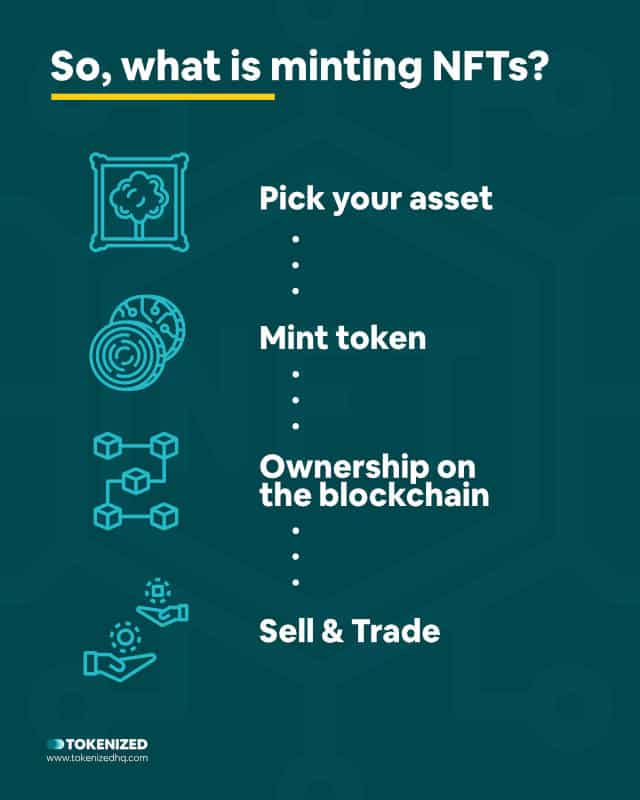
The process of minting an NFT is how a digital piece of art (or any other digital item) becomes permanently etched into the public ledger of a blockchain.
Once it has been minted on the blockchain, the information can no longer be changed and is therefore tamper-proof.
The underlying asset is now represented as an NFT and can be purchased and traded in the market.
Every transaction involving the NFT is digitally tracked and is public information.
In short: When you mint an NFT, you are creating the initial entry for an item on a blockchain (usually Ethereum).
This entry is your immutable proof of ownership, which you may or may not sell and transfer to someone else at a later stage.
We’ll find out more about what does it mean to mint an NFT later in this article.
But first, let’s learn what an NFT actually is!
What Is an NFT?
An NFT (or non-fungible token) is a unit of data that is permanently stored on a blockchain. Once it is minted it can no longer be changed and becomes a unique asset, unlike fungible tokens such as cryptocurrencies. Types of NFTs include various forms of digital content such as images, videos, or audio files.
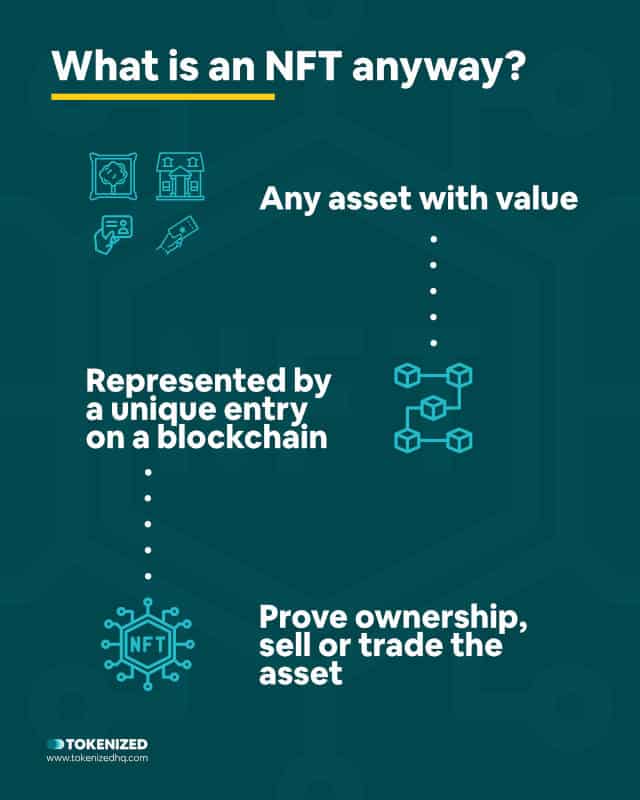
You’ve probably heard of NFTs before, but you’re most likely still not entirely sure what they are.
Actually, what does NFT even stand for?
Well, it stands for “non-fungible token” and it’s absolutely fine if you don’t know what that means.
Don’t worry because even though many people are already investing in NFTs or trading them for profit, the vast majority of people only have a fairly superficial understanding of what they are.
I mean, why else would so many people google “what does minting an nft mean“?
Unlike other cryptocurrency tokens such as Bitcoin (BTC) or Ethereum (ETH), NFTs are “non-fungible” tokens.
When something is “fungible”, then one item is interchangeable with the next.
One Bitcoin, or a fraction of it, is just as good as the next and there’s no specific way of tracking a partial “piece” of Bitcoin.
It all just mixes together, similar to other currencies or commodities such as oil and that is what we call “fungibility”.
However, NFTs are explicitly “non-fungible” tokens.
That means that every token is unique and unlike any other.
Even if 2 NFTs had the exact same name and used the same image to represent them on a marketplace, you would still be able to tell them apart.
How? By checking the public blockchain ledger and verifying each token address and token ID.
At this point, you might be starting to understand how relevant this distinction is.
So if ownership of a piece of art, a trading card, or maybe even real estate is determined by who owns the associated token, you can see how easy it is to verify who the owner is.
Every NFT is one of a kind, each with its own history.
And the blockchain preserves the rarity of this asset.
There are tons of examples of NFTs for various use cases, but let’s focus on minting first.
How Does NFT Minting Work?
Minting an NFT involves a number of steps. First, you must upload an image that will represent the token. Then you must add meaningful metadata to the token. And once you have saved your project, you can mint your non-fungible token. Minting your NFT will cost you transaction fees.
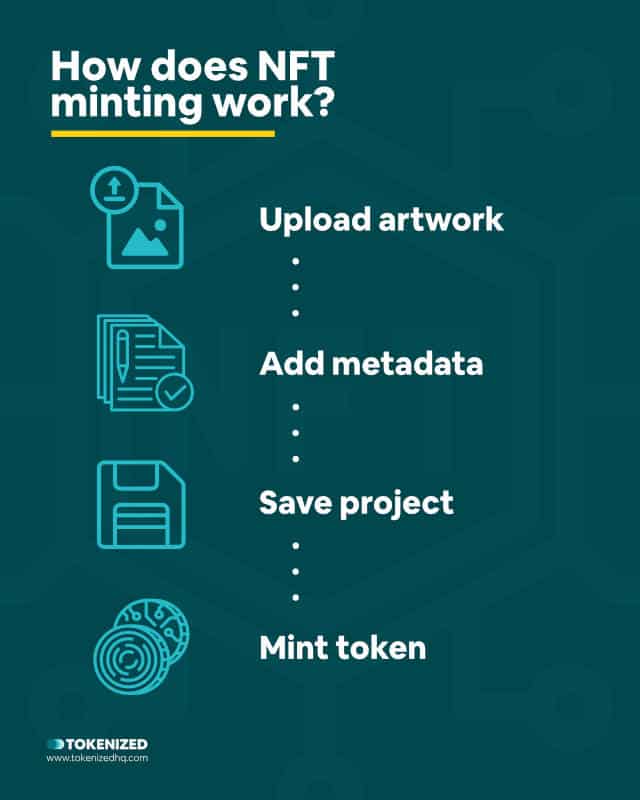
There are many different ways and locations where you can mint an NFT.
Most people will not want to deal with the complexities of developing your own custom smart contracts, which are the underlying code that governs a particular token or collection of tokens.
I mean, let’s face it. The question “what is NFT minting” is trending, so we’ll want to make things as simple as possible.
It essentially boils down to deciding which blockchain network and which marketplace you want to “mint” your NFT on.
For a list of potential NFT websites that you can use for this, check out our comprehensive list of NFT marketplaces and other tools in 2022
There are other tools involved, such as your cryptocurrency wallet, but we’ll deal with that in a separate article.
However, it’s worth mentioning that a basic understanding of using cryptocurrencies is definitely helpful in this space.
Other than that, once you’ve decided on where to mint your NFT, the process will boil down to the following steps:
- Artwork: Upload the image that should represent your NFT (e.g. artwork, trading cards)
- Metadata: Fill in the metadata for the NFT (title, description, unique traits)
- Save: Once you save your NFT, it can still be edited until you actually mint it.
- Mint: You can either mint your NFT yourself (this involves gas fees) or list it on the marketplace and have it minted upon purchase (this is called “lazy minting”).
So, how much does it cost to create an NFT?
Well, if you’re curious to know more about the cost to mint NFTs, we have a really nice article that goes into detail on the NFT minting cost.
What Are the Benefits of NFTs?
Some of the benefits of NFTs include the democratization of ownership, fair remuneration of creators and artists, the storage of “value” in a tradable item as well as the alignment of incentives between the creator and the owner of the NFT.
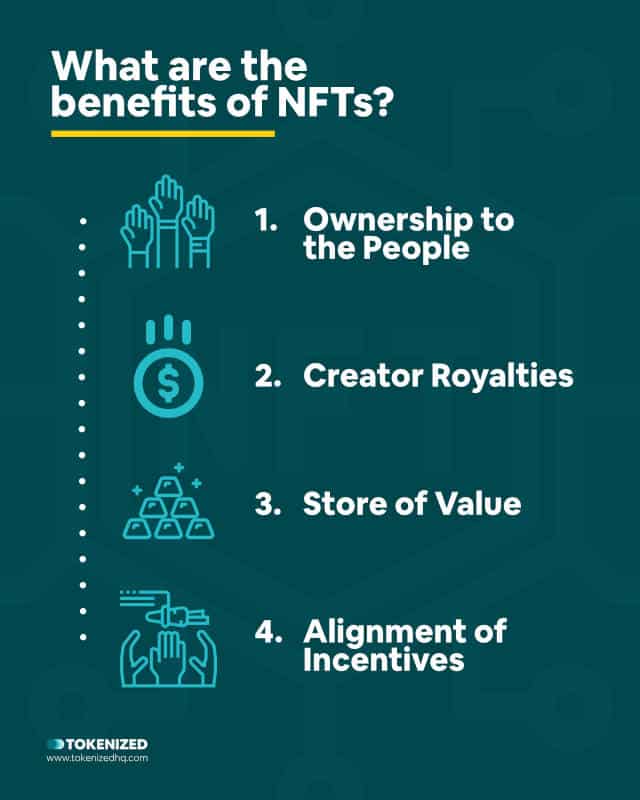
You might be wondering why any self-respecting artist would want to do this.
Particularly since so many artists are openly opposed to the concept of NFTs.
We strongly recommend you familiarize yourself with some of the answers to the question: Why do people hate NFTs so much?
This stance is particularly surprising given that artists are the ones who stand to gain the most from this concept.
What does it mean to mint an NFT?
Everyone has their own set of reasons why they might want to mint an NFT.
Nevertheless, there are a few benefits to NFTs which play a big role in their appeal:
- Ownership for the People: There is general consensus that NFTs will play a large part in democratizing ownership. When you make things ownable at every level, you are giving everyone the opportunity to own a stake in something. You can even take this to new extremes if you start fractionalizing ownership of assets (but that’s for another article).
- Creator Royalties: A major benefit of NFTs is that you can create them in a way that ensures that the original creator directly participates in the success of his work by guaranteeing him or her royalties on all secondary sales. This is fundamentally different from how the art market works today, where artists watch collectors make millions off of their work without them reaping any benefits other than fame.
- Storing Value: NFTs provide a unique opportunity to store value in a “tangible” way. The source of this value can be anything from monetary value to utility value. A specific token can come with benefits. And if the perceived value of a token increases, so will its market price.
- Alignment of Incentives: In many cases, NFTs can also represent a special form of membership for customers of a company. In this case, the customer also becomes a promoter of the company. Why? Because the value of his membership token will increase if the company becomes more successful.
How to Mint NFTs
Minting an NFT involves 5 basic steps. Creating your unique asset. Buying cryptocurrency to pay for transactions. Depositing the funds into your crypto wallet. Choosing the right marketplace to sell your NFT and finally, listing the NFT on the marketplace.
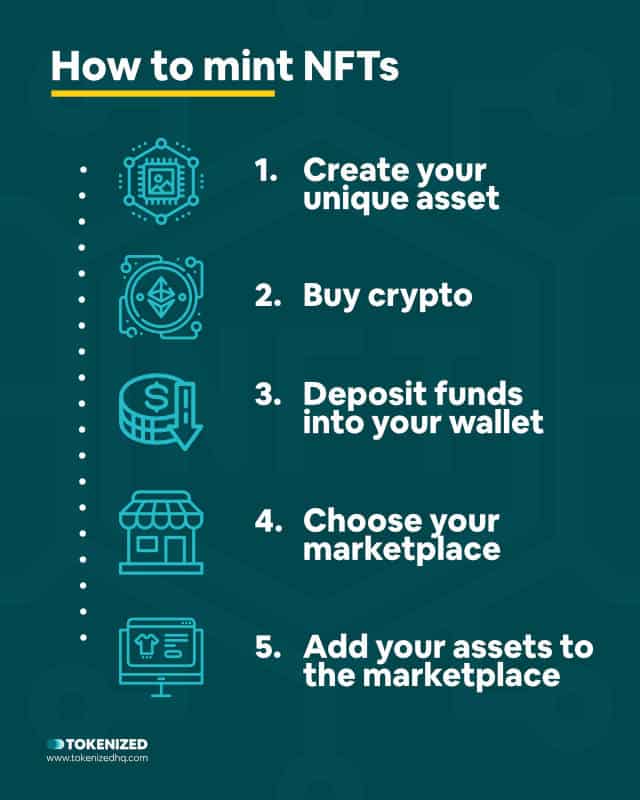
By now you probably understand what is NFT minting and what does minting an NFT mean.
But you probably want to create your own too, right?
Creating an NFT can be simple or complex and this article is not the place to go into all the nitty-gritty details of the process itself.
Nevertheless, there are a couple of decisions that you will have to make if you do decide to mint your own NFT.
These decisions are largely around what marketplace and what tools to use.
The basic steps are therefore roughly always the same.
1. Create Your Unique Asset
Decide what sort of asset you want to create.
The possibilities are literally endless and can range from basic digital artwork to special in-game items.
In some places, they are digital land plots within a game (e.g. The Sandbox) and in other cases, they give you access to a real-life restaurant in New York City (e.g. FlyFish Club).
If you want to keep it simple and stick to artwork, you’ll need to translate that artwork into data that lives on the blockchain.
That doesn’t mean that the artwork itself is stored on the blockchain, but the key metadata that represents it.
Ethereum is the most popular choice for NFTs right now, but it also happens to be the most expensive in terms of cost (we have a detailed guide on how much it costs to create an NFT right here).
2. Buy Crypto
If you want to do anything on any blockchain, you’re going to need cryptocurrency or tokens.
Whichever blockchain you choose will ultimately narrow down your choices of marketplaces and wallet services, because not all of them are interchangeable.
In the case of Ethereum, you’re going to need Ether (ETH), which is the native cryptocurrency.
You can buy some at a crypto exchange of your choice or directly via the OpenSea Credit Card feature (facilitated by MoonPay).
3. Deposit Funds Into Your Wallet
At this point, it is very important to point out that in the vast majority of cases you’ll need a non-custodial wallet.
That means that you need to be managing that wallet yourself.
A so-called “hot wallet” on an exchange will not work because the cryptocurrency isn’t actually in your own wallet.
It’s in the exchange’s wallet and they simply display it on their dashboard as if it was yours.
This is not fundamentally different from our current banking system and it also means that if anything happens to the exchange, you may lose your funds.
So remember, make sure you have those tokens in your non-custodial (or self-custody) wallet.
4. Choose Your Marketplace
There are a whole bunch of different marketplaces out there, but the market is essentially controlled by 2-3 players: OpenSea, Rarible, and Foundation.
And OpenSea is the biggest marketplace right now.
Foundation is also a bit special because they work with an invitation-only system.
Depending on the marketplace, they will charge you different types of fees for a number of things.
This may include setting up your account for listings, listing an NFT for auction, and many other things.
For a better overview of the costs associated with minting an NFT, make sure to check out our guide on how much it costs to create an NFT.
If you’re specifically interested in what fees are charged for minting or listing NFTs on OpenSea, please refer to our extensive guide on OpenSea fees.
5. Add Your Assets to the Marketplace
While each marketplace varies, the process is ultimately always the same.
Upload your artwork, fill in the metadata (title, description, etc) and mint the NFT directly yourself or have it minted upon purchase (this is called “lazy minting”).
Once you’ve created your NFTs you can list them for sale and promote your artwork to your loyal fans!
Can’t find your NFTs inside your MetaMask wallet?
No problem, check out our simple 5-step guide on how to add NFT MetaMask and you’ll have that fixed in no time.
Or just switch to another wallet provider.
Most of the bigger MetaMask alternatives don’t have problems displaying NFTs.
Frequently Asked Questions (FAQ)
Before we wrap up, let’s quickly address a few frequently asked questions that many people have in relation to minting NFTs.
-
What does minting NFTs mean?
The process of creating an NFT by executing a blockchain transaction is also known as “minting”, similar to how coins are minted by a central bank. It effectively means that an entry has been created on the blockchain with all of the details of the NFT and it can no longer to changed.
-
Does minting NFTs cost money?
Different blockchains have different types of transaction fees. Some are higher due to their consensus mechanism and high demand, while others are considerably lower. However, in the end, minting a true NFT will nearly always cost money. After all, someone needs to pay for the transaction.
-
Is minting NFTs the same as buying?
Buying an NFT is not necessarily the same thing as buying an NFT. If you purchase an NFT on the secondary market, then you are simply buying an NFT from someone else. Minting an NFT is the act of paying for the original transaction that creates the NFT from the primary smart contract of the collection.
-
Why is minting NFTs so expensive?
Minting NFTs does not have to be expensive. However, due to the extreme popularity of Ethereum and its very limited block capacity, minting an NFT in 2021 became unbelievably expensive. On most proof-of-stake blockchains, the cost of minting an NFT is negligible.
Conclusion
While cryptocurrency, NFTs, and minting might all seem a bit overwhelming at first, it’s really not as complicated as it often sounds.
You made the right choice in searching for “what is NFT minting” or “what does minting an NFT mean“.
However, the best way to learn in this space is to stop trying to learn things in theory and instead just dive in and get your hands dirty.
While that may mean that you’ll make a few mistakes here and there, consider it a valuable investment into your education.
You’ll quickly understand what it means to mint an NFT.
Cryptocurrency and NFTs are here to stay and they will most likely impact your daily lives much sooner than we all think.
The impact will most likely go far beyond the relatively basic world of art that we see today.
Here at Tokenized, we want to help you learn as much as possible about the coming NFT revolution. We help you navigate this fascinating new world of non-fungible tokens and show you how you can integrate tokenization into your own business.



